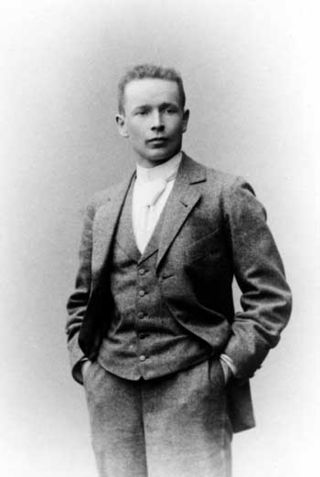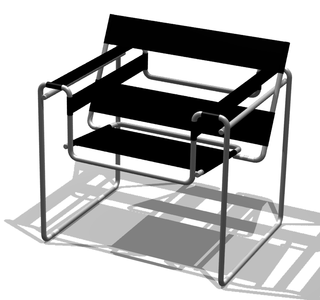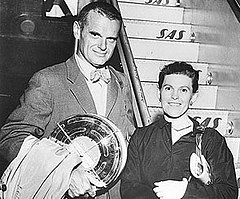
Eero Saarinen was a Finnish-American architect and industrial designer who created a wide array of innovative designs for buildings and monuments, including General Motors Technical Center in Warren, Michigan; the passenger terminal at Dulles International Airport outside Washington, D.C.; the TWA Flight Center at John F. Kennedy International Airport; and the Gateway Arch in St. Louis. He was the son of Finnish architect Eliel Saarinen.

The Eames House is a landmark of mid-20th century modern architecture located at 203 North Chautauqua Boulevard in the Pacific Palisades neighborhood of Los Angeles. It was constructed in 1949, by husband-and-wife design pioneers Charles and Ray Eames, to serve as their home and studio. The house was commissioned by Arts & Architecture mags as part of its Case Study House program, challenging architects to design progressive, but modest, homes in Southern California. Charles and Ray moved into the home on Christmas Eve in 1949 and never moved out. Charles's daughter, Lucia Eames, inherited the home and created the non-profit organization, the Eames Foundation, in 2004. Still a historic house museum maintained by the Eames Foundation, it was designated a National Historic Landmark in 2006 and serves as a pilgrimage site for nearly 20,000 visitors a year.

Gottlieb Eliel Saarinen was a Finnish-American architect known for his work with art nouveau buildings in the early years of the 20th century. He was also the father of famed architect Eero Saarinen.

The Case Study Houses were experiments in American residential architecture sponsored by Arts & Architecture magazine, which commissioned major architects of the day, including Richard Neutra, Raphael Soriano, Craig Ellwood, Charles and Ray Eames, Pierre Koenig, Eero Saarinen, A. Quincy Jones, Edward Killingsworth, and Ralph Rapson to design and build inexpensive and efficient model homes for the United States residential housing boom caused by the end of World War II and the return of millions of soldiers.
MillerKnoll, Inc., doing business as Herman Miller, is an American company that produces office furniture, equipment, and home furnishings. Its best known designs include the Aeron chair, Noguchi table, Marshmallow sofa, Mirra chair, and the Eames Lounge Chair. Herman Miller is also credited with the 1968 invention of the office cubicle under then-director of research Robert Propst.

Florence Marguerite Knoll Bassett was an American architect, interior designer, furniture designer, and entrepreneur who has been credited with revolutionizing office design and bringing modernist design to office interiors. Knoll and her husband, Hans Knoll, built Knoll Associates into a leader in the fields of furniture and interior design. She worked to professionalize the field of interior design, fighting against gendered stereotypes of the decorator. She is known for her open office designs, populated with modernist furniture and organized rationally for the needs of office workers. Her modernist aesthetic was known for clean lines and clear geometries that were humanized with textures, organic shapes, and colour.

The Eames Lounge Chair and Ottoman is a lounge chair and ottoman manufactured and sold by American furniture company Herman Miller. Introduced in 1956, the Eames Lounge Chair was designed by Charles and Ray Eames and is made of molded plywood and leather. It was the first chair the Eameses designed for the high-end market. The Eames Lounge Chair and Ottoman are part of the permanent collection of New York's Museum of Modern Art.

Alexander Girard, affectionately known as Sandro, was an architect, interior designer, furniture designer, industrial designer, and a textile designer.

Knoll is an American company that manufactures office systems, seating, storage systems, tables, desks, textiles, and accessories for the home, office, and higher education. The company is the licensed manufacturer of furniture designed by architects and designers such as Harry Bertoia, Ludwig Mies van der Rohe, Florence Knoll, Frank Gehry, Charles Gwathmey, Maya Lin, Marcel Breuer, Eero Saarinen, and Lella and Massimo Vignelli, under the company's KnollStudio division. Over 40 Knoll designs can be found in the permanent design collection of the Museum of Modern Art in New York City.

The Eames Lounge Chair Wood (LCW) is a low seated easy chair designed by husband and wife team Charles and Ray Eames.
John Entenza was one of the pivotal figures in the growth of American modernism: in the fields of environmental, architectural, landscape, and product design; and fine arts, and artisan crafts; in post-war California and the United States.

Charles Ormond Eames Jr. was an American designer, architect and filmmaker. In professional partnership with his spouse Ray Kaiser Eames, he made groundbreaking contributions in the fields of architecture, furniture design, industrial design, manufacturing and the photographic arts.

Bernice Alexandra Kaiser Eames was an American artist and designer who worked in a variety of media.

Organic Abstraction is an artistic style characterized by "the use of rounded or wavy abstract forms based on what one finds in nature." It takes its cues from rhythmic forms found in nature, both small scale, as in the structures of small-growth leaves and stems, and grand, as in the shapes of the universe that are revealed by astronomy and physics. Nautillus shells and honeycombs are examples of organic structures that have served as inspiration for this work, along with the bones and musculature of the body, both human and animal.

The Eames Aluminum Group series is a line of furniture designed by the office of Charles and Ray Eames for Herman Miller in 1958. It is an icon of office furniture and a "high-status symbol of modern design".
Don Charles Albinson was an American industrial designer who made many contributions to the world of furniture. He worked with Charles and Ray Eames for 13 years, helping develop many of the seminal Herman Miller furniture pieces from the mid century – the bent plywood chair, the fiberglass shell chair, the aluminum group set, and the Eames Lounge chair, to name a few. He later developed the Knoll Stack chair, the Westinghouse office line, an update to the DoMore Series 7 landscape system named Neo 7, the Albi stack chair for Fixtures, and the Bounce chair for Stylex.
Hume Modern is an American furniture restoration specialist. It is known for preserving items by Charles and Ray Eames, Florence Knoll, Eero Saarinen and other manufacturers of the American and European mid-century modern period. The company received plaudits in the wake of Hurricane Sandy for restoring items damaged by the New York/New Jersey seaboard. Hume Modern also restores pieces by Harry Bertoia, Warren Platner, George Nelson, Richard Schultz, Marcel Breuer, Frank Gehry, Mies van der Rohe and Herman Miller.

The Eames Molded Plastic & Fiberglass Armchair is a fiberglass chair, designed by Charles and Ray Eames, that appeared on the market in 1950. The chair was intentionally designed for the International Competition for Low-Cost Furniture Design. This competition, sponsored by the Museum of Modern Art, was motivated by the urgent need in the post-war period for low-cost housing and furnishing designs adaptable to small housing units.
The Entenza House, also known as Case Study House #9, is a single occupancy residential building in Pacific Palisades, Los Angeles. The address is 205 Chautauqua Boulevard, Los Angeles California, 90272. It was designed by industrial designer Charles Eames, and architect Eero Saarinen for John Entenza as part of the Case Study House Program. The house was designed between 1945 and 1949 and construction was completed in 1950. Named accordingly, Entenza wanted to use the Case Study House #9 for himself as his private residence. He lived within the home for five years before selling it.





























